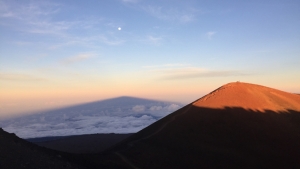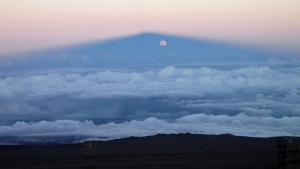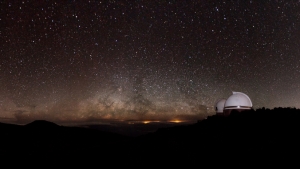The University of Hawaiʻi is seeking broad community feedback on a draft of a new Maunakea Master Plan that will guide land-use decisions on UH-managed Maunakea lands. The overarching goals of the plan are to reduce impacts to the natural resources, especially in the summit region, by limiting development; to create better balance among cultural, environmental, scientific and recreational interests; and to broaden Native Hawaiian and community participation in planning and programming.
 The existing Master Plan was adopted in 2000 and established the Maunakea Management Board and Kahu Kū Mauna community volunteer advisory groups. The 2000 Master Plan covered facility design standards, the project review process for proposed land uses on Maunakea, and roadway improvements/modifications.
The existing Master Plan was adopted in 2000 and established the Maunakea Management Board and Kahu Kū Mauna community volunteer advisory groups. The 2000 Master Plan covered facility design standards, the project review process for proposed land uses on Maunakea, and roadway improvements/modifications.
The draft of the new plan, Master Plan for the University of Hawaiʻi Maunakea Lands; E Ō I Ka Leo (Listen to the Voice), will serve as a framework for aligning land-use decisions, management actions and educational programs that strengthen a sense of, and connection to, the mauna.
Key highlights of the plan include:
- Fortification of UH’s commitment of no more than nine operating astronomy facilities on Maunakea by December 31, 2033.
- Providing mechanisms to seek and consider input from the native Hawaiian community and the broader community in the decision-making framework.
- Support for the UH Hilo Educational Telescope at Halepōhaku (the mid-level facility).
- Establishing a UH Hilo-led “Multi-disciplinary Field Station” at Halepōhaku to support field studies and learning experiences across disciplines.
- Maintaining the Maunakea Observatories’ status as world leaders in astronomy.
 Activities like hunting, gathering, recreation and traditional and customary practices are activities addressed in the Mauna Kea Comprehensive Management Plan (CMP), which is being updated.
Activities like hunting, gathering, recreation and traditional and customary practices are activities addressed in the Mauna Kea Comprehensive Management Plan (CMP), which is being updated.
The draft 122-page Master Plan also incorporates the major management changes adopted over the past two decades including Board of Land and Natural Resources (BLNR) approval of the CMP in 2009; the four CMP sub-plans (relating to public access, cultural resources management, natural resources management and observatory decommissioning); the administrative rules for public and commercial activities in 2020, and the establishment of the UH Hilo Center of Maunakea Stewardship (CMS) in 2020. CMS is responsible for administering both management plans and the administrative rules.
“The University of Hawaiʻi is privileged to be among the stewards of Maunakea, and this plan is responsive to the many values and obligations that we as an institution have for managing public lands,” said CMS Executive Director Greg Chun. “Everyone has a legitimate interest in what happens to these lands and how they are utilized. We strongly encourage everyone to play a role in this master plan’s development and tell us what they think.”
Chun will participate in a virtual public meeting with the new Master Plan tentatively scheduled for October 6 from 5 to 7 p.m. More information will be announced by Monday, September 20.
Review and submit comments
 The public can review and provide comments directly to the draft at the Maunakea Master Plan website (https://maunakea.konveio.com/), an online platform that simplifies public review and engagement for greater convenience.
The public can review and provide comments directly to the draft at the Maunakea Master Plan website (https://maunakea.konveio.com/), an online platform that simplifies public review and engagement for greater convenience.
UH strongly encourages the public to utilize the Maunakea Master Plan website that also provides background information on the draft and multiple ways to provide feedback.
Comments and recommendations may be made online, via telephone messages and U.S. Postal Service. The Maunakea Master Plan website also has contact information and instructions on how to prepare and send comments via each of these methods. UH is accepting input on this draft plan through October 26, 2021.
All public comments/feedback will be taken into consideration as the draft is amended before going to the UH Board of Regents for review and possibly further changes before final approval, which is expected in early 2022.
FAQs
- What is the Maunakea Master Plan?
- Why is a new Master Plan needed, and what is the difference between the existing plan and the Master Plan adopted in 2000?
- Why is UH pursuing a new Master Plan when there is a chance it will lose its land authorization for Maunakea lands?
- What is the difference between the proposed Master Plan and the Comprehensive Management Plan?
- Who is responsible for implementing the new Master Plan?
- Where can I view the draft of the new Master Plan?
- How can I provide feedback to the proposed Master Plan?
- What is the deadline for public feedback?
- What happens after the public comment period?
- Will the land uses discussed in the Master Plan require environmental review and permits?
- How does the new Master Plan impact traditional and customary Native Hawaiian practices?
- How does the proposed new Master Plan impact the Thirty Meter Telescope (TMT) project?
- What role does the Hawaiʻi Board of Land and Natural Resources play as the lessor and regulator of the lands leased or allowed by easement to UH?
- What is the Center for Maunakea Stewardship?
What is the Maunakea Master Plan?
Originally passed in 2000, the Master Plan guides land use decisions within the UH-managed lands on Maunakea, addressing the planning, siting and design of new facilities and significant changes to existing facilities. The Master Plan is approved by the UH Board of Regents.
It is one of two distinct but complementary plans that, along with the administrative rules for public and commercial activities, guide UH’s stewardship of Maunakea. The second plan approved in 2009 by the Hawaiʻi Board of Land and Natural Resources (BLNR) is the Comprehensive Management Plan (CMP). Its update will be approved by the UH Board of Regents and BLNR. The CMP addresses management of activities and resources within the UH Maunakea Lands. Activities addressed in the CMP include public access, cultural resources management, natural resources management and observatory decommissioning.
The new master plan, the Master Plan for the University of Hawaiʻi Maunakea Lands; E Ō I Ka Leo (Listen to the Voice) replaces the 2000 Mauna Kea Science Reserve Master Plan and applies the same definition of “land use” used by the BLNR, as all final land-use decisions on Maunakea ultimately require the state land board approval.
The overarching goals of the new Master Plan are to reduce impacts to the resources, especially in the summit region, by limiting development; to create better balance among cultural, environmental, scientific and recreational interests; and to broaden Native Hawaiian and community participation in planning and programming.
The Master Plan does not make any final decisions on any facilities or land uses. The programs and projects identified and discussed in the new Master Plan are concepts that UH is considering and/or may be proposing but which it has not approved, adopted, or funded.
Why is a new Master Plan needed, and what is the difference between the existing plan and the Master Plan adopted in 2000?
The existing Master Plan, adopted in 2000, has a 20-year lifespan. The new Master Plan reflects new and updated priorities including reducing impacts to natural resources, especially in the summit region, by limiting development; creating better balance among cultural, environmental, scientific and recreational interests; and broadening Native Hawaiian and community participation in planning and programming.
It also incorporates the management changes since 2000, including the Comprehensive Management Plan (CMP) adopted by the Board of Land and Natural Resources (BLNR) in 2009; the four CMP sub-plans (public access, cultural resources management, natural resources management and observatory decommissioning) adopted by BLNR in 2009 and 2010; the administrative rules for public and commercial activities (PDF), adopted by the University Board of Regents in 2019 and approved by the governor in 2020; and the establishment of the UH Hilo Center for Maunakea Stewardship (CMS) in 2020.
Other key highlights include:
- Fortification of UH’s commitment of no more than nine operating astronomy facilities on Maunakea by December 31, 2033.
- Providing mechanisms to seek and consider input from the Native Hawaiian community and the broader community in the decision-making framework.
- Support for the UH Hilo Educational Telescope at Halepōhaku (the mid-level facility).
- Establishing a UH Hilo-led “Multi-disciplinary Field Station” at Halepōhaku to support field studies and learning experiences across disciplines.
- Maintaining the Maunakea Observatories’ status as world leaders in astronomy.
Why is UH pursuing a new Master Plan when there is a chance it will lose its land authorization for Maunakea lands?
UH’s lease with DLNR terminates at the end of 2033, twelve years from now. UH is and always has been scheduled to update the plan as the existing Master Plan was adopted in 2000 with a 20-year lifespan. It would be irresponsible for UH not to develop a New Master Plan even with questions surrounding a future land authorization. Whether UH remains the land manager, or if there is ultimately a new management entity for Maunakea, the new Master Plan and the Comprehensive Management Plan and administrative rules for public and commercial activities will be valuable assets to planning for activities and management of resources moving forward.
What is the difference between the proposed Master Plan and the Comprehensive Management Plan?
The new Master Plan addresses the planning, siting and design of new facilities and significant material changes to existing facilities. Its focus is “land use” as that term is defined under the Department of Land and Natural Resources conservation district rules, since land use decisions on Maunakea all occur within the state conservation district. The Comprehensive Management Plan (CMP) addresses management of activities and resources. The new Master Plan does not replace the CMP, the plans are consistent and complement one another. Both plans are intended to be implemented together.
Who is responsible for implementing the new Master Plan?
This Master Plan will be implemented by the UH Hilo Center for Maunakea Stewardship (CMS), part of a governance structure approved by the Board of Regents in 2002. CMS is advised by the Maunakea Management Board, Kahu Kū Mauna, and the Environment Committee, all of whom are volunteers who bring broad community perspectives and subject matter expertise to inform UH decisions.
Where can I view the draft of the new Master Plan?
The public can view and provide comments directly to the draft at the Maunakea Master Plan website (https://maunakea.konveio.com/), an online platform that simplifies review and engagement for the public.
UH strongly encourages the public to utilize the Maunakea Master Plan website that also provides background information on the draft and multiple ways to provide feedback.
How can I provide feedback to the proposed Master Plan?
Comments and recommendations regarding the draft Master Plan may be made online, via telephone messages and U.S. Postal Service. The Maunakea Master Plan website also has contact information and instructions on how to prepare and send comments via each of these methods.
UH strongly encourages the public to utilize the Maunakea Master Plan website that also provides background information on the draft and multiple ways to provide feedback.
What is the deadline for public feedback?
The public comment period starts on Sunday, September 12, and will run through Tuesday, October 26.
What happens after the public comment period?
All public comments and recommendations will be taken into consideration as the draft is amended and finalized before going to the UH Board of Regents for review and possibly further changes before approval, which is expected in early 2022.
Will the land uses discussed in the Master Plan require environmental review and permits?
The new Master Plan does not involve projects that UH has approved, adopted or funded. An exemption, environmental assessment and/or environmental impact statement will be prepared under the Hawaiʻi Environmental Policy Act before a project is initiated on Maunakea. If federal funds are used for any projects, they may also require compliance with the National Environmental Policy Act. Projects will also require other permits and approvals, in particular, approvals from the Board of Land and Natural Resources or the Department of Land and Natural Resources under its conservation district rules, depending on the type of land use proposed.
How does the new Master Plan impact traditional and customary Native Hawaiian practices?
The decision-making framework in the new Master Plan does not cover the gathering of natural resources for personal, noncommercial use related to traditional and customary Native Hawaiian practices. This is consistent with the definition of “land use” under the Conservation District administrative rules, which the new Master Plan adopts. Consequently, activities such as traditional and customary Native Hawaiian practices and recreational activities are not subject to the Master Plan. The management of activities for the protection of resources are governed under the Maunakea Comprehensive Management Plan (CMP) and the Maunakea administrative rules.
How does the proposed new Master Plan impact the Thirty Meter Telescope (TMT) project?
The new Master Plan does not impact the TMT project, which holds a Conservation District Use Permit (CDUP) to build an astronomy facility on what the new Master Plan identifies as Astronomy Site 13. If TMT is not built, Astronomy Site 13 may be used for another project.
What role does the Hawaiʻi Board of Land and Natural Resources play as the lessor and regulator of the lands leased or allowed by easement to UH?
As the regulator of land uses within the Conservation District, all final land use decisions on Maunakea ultimately require the approval of the Department of Land and Natural Resources (DLNR) or the Board of Land and Natural Resources (BLNR). The new Master Plan applies the same definition of “land use” used by the BLNR: (1) the placement or erection of any solid material on land if that material remains on the land more than 30 days, or which causes a permanent change in the land area on which it occurs; (2) the grading, removing, harvesting, dredging, mining, or extraction of any material or natural resource on land; (3) the subdivision of land; or (4) the construction, reconstruction, demolition, or alteration of any structure, building, or facility on land. In addition, the term “land use” does not include the gathering of natural resources for personal, noncommercial use for traditional and customary Hawaiian practices.
As the lessee of the lands UH manages on Maunakea, UH must comply with conditions found within the general lease and easements granted by BLNR to UH. UH must also obtain BLNR’s consent before it subleases lands to other parties.
What is the Center for Maunakea Stewardship?
The Center for Maunakea Stewardship (CMS) combines the Office of Maunakea Management and Maunakea Support Services, and formalizes the collaborative roles of the UH Institute for Astronomy and UH Hilo ʻImiloa Astronomy Center. CMS is responsible for the strategic implementation of stewardship programs such as native plant restoration, protection of flora and fauna and invasive species prevention; planning, permitting, compliance oversight, outreach, and research and academic coordination, as well as for fiscal planning and management.

